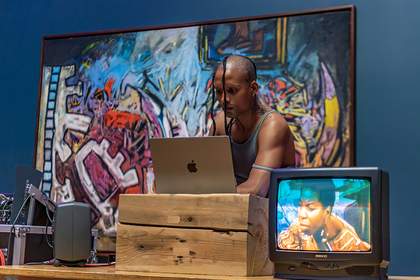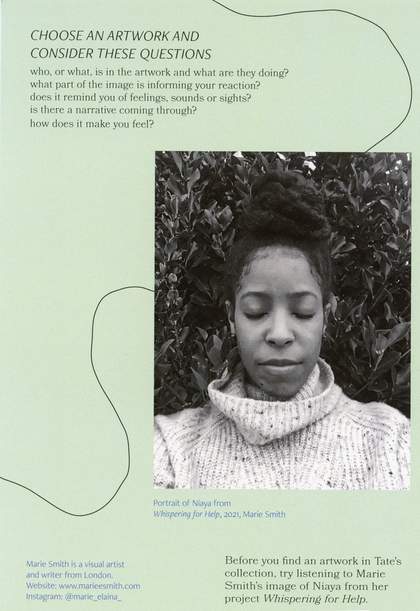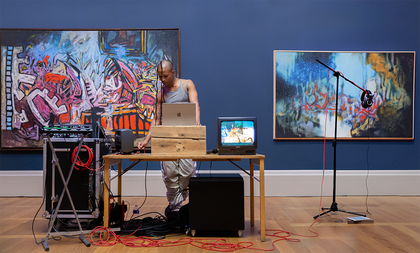Informed by research into Tate’s collection, the Interpretation Artist in Residence programme aims to facilitate artist development and open up new ways for audiences to engage with artworks at Tate. We support practice-based research, inviting artists to make work that highlights how art can foster new connections, collaborations and conversations between artists, artworks and audiences.
Joshua Woolford
2023–4
How can sound be used to surface untold or hidden stories surrounding artworks? Does sound allow us to form new relationships with and connections to art? Responding to these questions throughout a year-long artist residency, Joshua Woolford created six new sound pieces for collection artworks on display at Tate Britain. Throughout their residency Woolford explored the potential of sound to create dialogues with artworks through talks, sound pieces and live performances.
Over the course of 12 months Woolford created and shared live performances, at the Queer and Now festival in June 2023 and the Late at Tate Britain: Desire, Culture and History in August 2023. They hosted a sound workshop with the local youth organisation City Lions and held a reading group between Tate and iniva with PRIM, a platform for queer Black storytelling.
Woolford has actively explored the power and potential of ‘building communities around questions’. Throughout the residency they collaborated with a number of artists and musicians including Tawiah, Lie Ning, Tia Simon-Campbell (Sippin’ T), Tereza Delzz, Zein Majali, Kenichi Iwasa, Anne Duffau and Nwakke.

Joshua Woolford, Live Performance at Tate Britain, 2023
Photo: Eugenio Falcion (Page header photo: Anna-Lena Krause)
In response to Mona Hatoum's Present Tense 1996 (Tate T13867) Woolford connected with Radio Alhara and Learning Palestine to create a sound piece, which included elements from their 12-hour radio programmes and excerpts from Jayce Salloum’s interview with Soha Bechara alongside field recordings of artisanal soap-making in the West Bank of Occupied Palestine, recorded by Morgan Totah from Handmade Palestine. Through building these networks and dialogues around artworks, Woolford surfaced new narratives around Tate’s collection.
The history of the modern museum is a story of how imperialism was presented to Western audiences as a project at once humane, aesthetically pleasing, and scientifically important. If we are to decolonize museums as they exist today, we must first understand these colonial roots. We must untangle the ‘vineyards of consciousness’ by which cultural institutions such as museums have historically ordered culture, nature, and society, thereby structuring the way we think about such matters today.
Shimrit Lee, Decolonize Museums (2022)
Marie Smith
2022–3
Tune into the counterintuitive: What is the frequency of Tate Britain?
What does an artwork sound like? Marie Smith‘s artist residency explored how we might engage with artworks through different senses such as listening. Through her own art practice as a photographer and researcher, she investigated what artworks might sound like, responding to Tina Campt’s book Listening to Images (2017). Campt’s theory explores how to move beyond just looking at a photograph to think through how we can see, feel and even listen to images.
Smith‘s residency project utilised sound and spoken word as interpretative strategies. Residency outputs included a workshop with Tate Collective producers that put into practice the theory of ‘listening to images’, an event at Late at Tate Britain and sonic responses by Tate Collective producers recorded by Falling Tree Productions and installed in the display Sixty Years: The Unfinished Conversation at Tate Britain.

What is the Frequency of Tate Britain?, workshop leaflet
Design: Max Ferguson
Smith also initiated a collaborative project with Shade Podcast, Theatre Peckham artists Imogen Faires and Jamel Alatise and artist Liz Johnson Artur, in response to Johnson’s display Time don’t run here at Tate Modern. She developed a workshop with Artur, Faires and Alatise, leading to live performances in the gallery as Faires and Alatise performed a new collaborative poem written in response to Artur‘s work and Campt‘s theory of ‘listening to images’. This was followed by the creation of the sound installation Interludes: Black Balloons by Axel Kacoutié and Lou Mensah, which was installed in the gallery temporarily and available online.
Smith (she/they) is a neurodivergent visual artist and writer. She is a lecturer in the School of Design at Kingston University London and a member of Black Women Photographers. Being a neurodivergent person with dyspraxia and anxiety has informed how she navigates the world. Smith’s practice incorporates audio, digital and analogue media alongside text as a form of visual language that addresses identity, the body, nature, sustainability, mental health and well-being.
The Artist in Residence programme is curated and managed by Hannah Geddes, Curator, Research and Interpretation.

